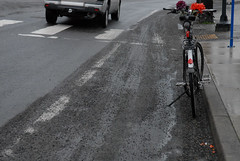A new paper to be published later this year by a team of doctors and nurses from Oregon Health Sciences University (OHSU) has found that roadway conditions and “the commuting environment” play an important factor in the incidence rate of injuries sustained while riding.
The paper, Bike commuter injury prevention: it’s time to focus on the environment, is the result of a study launched back in September 2007. It tracked 962 people who ride their bikes to work and it monitored them through monthly surveys.
According to the paper’s primary author, Red Hoffman, ND, there were three specific aims of the study: to determine the volume and severity of “traumatic events” (injuries) that happened to the subjects, to determine how the subject’s personal characteristics (such as skill level or age) might have contributed to the injury, and to learn how “environmental factors” such as roadway surface conditions influence the rate and severity of the injuries.
The study subjects were evenly split between male and female, ranged in age from 22 to 70 years old, and commuted by bike an average of 135 miles per month. As for riding skill level, 23% were beginners, 27% were intermediate, and 50% were advanced.
Hoffman says the incidence rate of “traumatic events” (which led to injuries) was 15 per 100,000 miles ridden and the incidence for “serious traumatic events” (which led to injuries requiring medical attention) was 3.9 per 100,000. Or, put another way, during the one-year study, nearly 20% of bike commuters in the survey experienced a “traumatic event” and 5% required medical attention.
The study found that, “There were no differences in age, gender, safety practices and experience levels between commuters who experienced a TE [traumatic event] and those who did not.”
“One finding I thought was interesting,” said Hoffman, “is that poor roadway surface conditions played a role in 20% of the traumatic events — gravel on the road, rail tracks on the road, steel plates in the road, and so on… led to these events.”
The study also found that 48% of the “serious traumatic events” involved motor vehicles.
Hoffman presented the paper at the annual meeting of the Eastern Association for the Surgery of Trauma last month and she won the John M. Templeton, Jr., MD Injury Prevention Paper Competition.
The paper will be published in the Journal of Trauma later this year (I’ll do a follow-up story with a link to the full paper once it’s published). Co-authors on the paper were William Lambert, PhD and Ellen Peck, RN. The Principal Investigator was John Mayberry, MD.






Thanks for reading.
BikePortland has served this community with independent community journalism since 2005. We rely on subscriptions from readers like you to survive. Your financial support is vital in keeping this valuable resource alive and well.
Please subscribe today to strengthen and expand our work.
Is there a link to this paper? I’d love to read it. The finding that experience does not play a statistically significant factor in rate of injuries surprises me.
The Biking Viking,
Sorry, no link to the paper because it’s not published yet. OHSU gave me an early peek. As for the experience level/injury rate…. Hoffman said it comes down to a factor of miles in the saddle… the more miles you put in the more likely you are to have a crash/injury.
I was one of the 962, and got through that 12-month period without a traumatic event. Filling out the monthly survey was an interesting and valuable reflective practice. I Look forward to reading the full report, and hope the results find good use.
How does this data agree with other data that existed previously? Did they track whether riding on arterials (like MLK for example) affected crash rates?
Just as interesting to me is that to the investigator ““One finding I thought was interesting,” said Hoffman, “is that poor roadway surface conditions played a role in 20% of the traumatic events…””
That this should surprise anyone is shocking. My belief is that (at least up here) bike facilities are so indifferently and uncomprehendingly built as to be essentially a worthless PR gesture by the Seattle Dept. Of Tranportation.
Gravel and asphalt debris, standing water are concentrated in that margin of the road the Motoring-focused SDOT deigns to leave to us. Unless, of course it’s a bike-specific facility (read: mixed use path) in which case add tree roots buckling the pavement, chicanes, bollards, a 15 mph speed limit when you cross the city line, and iPod wearing pedestrians walking their dogs on those spool-feed leashes.
What did Sarah Palin claim to say about the money for the bridge to nowhere?
It’s nice to finally see some attention to the actual causes of safety issues for cyclists, such as road conditions, proximity to automobiles, etc. Hopefully this kind of thing continuing to come up will prompt more actual solutions and less “put on a helmet and buck up!”
While I’ve still never crashed in a couple years of riding every day, the gravel like in your photo up there certainly makes me a bit nervous, and notably changes how my bike handles. Mix that with the right circumstances of poorly placed/absent bike lanes, and automobile traffic, and I’m certain your chance of taking a spill goes way up.
Like Mikael said riding in the cycle track on Broadway – “In Copenhagen, there wouldn’t be any leaves in it.” They’ve already figured out that nice surface = less accidents (not that it’s a huge logical leap or anything).
Much as I’d like to think that my skills directly affect my survival this study seems to suggest otherwise.
In a bit of amateur data analysis I think that might be a good thing. At first glance it looks like it absolves the cyclist of fault and lays it at the feet of the system.
Maybe the skill level is negated by increased risk taking, by the rider, e.g. risk homeostasis?
http://en.wikipedia.org/wiki/Risk_homeostasis
Considering the paucity of maintenance on the existing facilities, one has to expect that if PDOT does “Build It” that we would have lots more situations where gravel, mud, water or ice in the cycle path contribute to a fall.
My last tumble was on waterfront park when I hit a patch of slime left by a blocked drain.
Any program that creates biking facilities should consider the maintenance needs of that facility and the funding thereof.
@ JAT in Seattle # 5 –
You actually listened to that woman?
well, to the extent that the posting here is about the research paper of which she is the primary author, I did.
Was that inadvertantly naive of me?…
“interesting” does not equal “surprising”
@ JAT –
LOL I meant Sarah Palin, not Hoffman! Shoulda been more specific with my silly quip. 🙂
Jonathan, I’d love to read a Q + A Bike Portland interview with the study author (pretty please).
‘The study also found that 48% of the “serious traumatic events” involved motor vehicles.’
Interesting, as I’d always heard that non-motor vehicle involved cyclist injuries were an estimated 80% of all crashes – I think that was based on a fairly old Seattle hospital emergency room study. This is a fair departure from that. Still, I think most rank n’ file cyclists would be amazed to learn that more than half of crashes don’t involve a motor vehicle.
I would agree that roadway surface is the biggest danger. I live on SE 42nd which has been torn apart, patched up, torn apart again, patched up again, etc. since at LEAST last August for the sewer-line/planter project. Riding home at night is always a thrill because sometimes the trenches in the road are filled with a sand/dirt combo which is not a good segue from hard pavement in the dark. The steel plates used at other locations can be a bit slick but are much more user-friendly.
On a positive note… I blew a front tire at 30mph commuting home in the dark on SW Skyline when I hit a nasty pothole.
No… that’s not the positive note.
I called 823-BUMP, left a message and the pothole was fixed within a couple of days.
Report hazards.
@Jonathan:
“As for the experience level/injury rate…. Hoffman said it comes down to a factor of miles in the saddle… the more miles you put in the more likely you are to have a crash/injury.”
I still don’t get it. Could you please clarify this once again? Is Hoffman saying that experience does not matter for crashes/injury per mile ridden or as the total over the time they did the survey? Or to make it more concrete: did both the experienced cyclist who rode 9,000 miles per year and the novice cyclist who cycles 1000 miles/year both have an average of 3 crashes in that year? Or did experienced cyclist have nine times as many crashes because she rode nine times as much?
This distinction seems to be crucial when it comes to judging the value of experience.
Andrew (#17) – yes, i’ve had similarly good luck with 823-BUMP. They’re fantastic about fixing the problem, but if you don’t tell ’em about it….it ain’t gonna happen. duh.
Best use of a cell phone to date. Put it on your speed dial. Be specific about location. Marvel at the responsiveness of your City at work.
Hi,
I want to take this opportunity to thank all of the commuters who participated in our study. We had an amazing response rate; over 70% of our participants answered 10 or more of the monthly surveys. Thank you for your time and support.
Allan- The incidence rates of both traumatic events and serious traumatic events were similar to three retrospective studies of bike commuters that have been published in the past ten or so years.
Harald- I’d like to clarify. First, I’m not saying that experience doesn’t matter. I am reporting that during this one year period, there was no statistically significant difference in skill level (or age, gender, BMI, safety practices or past event history) between riders who experienced a traumatic event (or a serious traumatic event) and riders who didn’t experience a traumatic event (or serious traumatic event). This statement is based on statistical analysis that does NOT take into account how many miles were ridden by the commuters. We also calculated the incidence rates of both traumatic events and serious traumatic events of all the skill levels separately; this analysis DOES take into account how many miles were ridden by the commuters. Here we found that there were no statistically significant differences in incidence rates of events between the different skill levels. The incidence rates take into account both the number of riders in each skill level as well as how many miles each group of riders had travelled. We then report all of the incidence rates per 100,000 miles travelled so we can basically compare “apples to apples.” This allows us to say (as in your example above) that the experienced cyclist who rode 9000 miles and the novice who rode 1000 miles will have a similar event rate if they each commute 100,000 miles. (and you can obviously do the math to reduce that 100,000 miles to 10,000 or 1000 miles). What does this mean for the average commuter reading this blog? I think looking at the incidence rate (for example, in our study, 15 traumatic events per 100,000 miles travelled) is useful for an individual rider. You can recalculate this number to say that any particular rider will have 1 traumatic event per every 6,666 miles travelled (regardless of age, gender, BMI, skill level, safety practices or previous event history). Please keep in mind that we define “traumatic event” as any injury that occurs as a result of a cycling and that a large number of the injuries reported were to the skin/soft tissue.
In reference to JeffS, and this study is about commuters. Presumably, they are riding different routes, at busier times, and in more conditions than other cyclists. But, they are more likely to be familiar with the route.
However, I would say that the auto related trauma incidents might stand out in a rider’s mind more than some of the other causes, making the subjective experience different from the statistics.
In the end, this is one study of many. Interesting results for sure, though.
There is another injury study being done by UBC
http://www.cher.ubc.ca/cyclingincities/injury.html
“Our study will examine the association between bicyclists’ injuries and the cycling environment (primarily the types of route, including integration or separation of the cyclist from motorized or pedestrian traffic; types of intersection; and presence of car parking and junctions).”
The results should be out soon.
@Red: Thanks for the clarification. I’m looking forward to reading the published article!
Red: I’m wondering if, in the study, you make note of what the spectrum of traumatic events is, or perhaps, the frequency of minor injuries (scrapes, bruises, etc) as compared to major injuries (broken bones, internal organ damage, etc), and what kinds of environmental factors (including automobiles being involved) were more or less likely to cause more or less severe injuries.
I think a lot of people get a bit of a skewed perspective of safety when they hear that everyone is going to have a “traumatic event” within 6,000 miles riding (which granted, is probably a couple of years for most non-recreational riders), when it seems likely that probably just means they’re going to skin their elbow and get some bruises in that time, not anything really “traumatic” (or maybe the study shows they are likely to have something more traumatic happen in those 6,000 miles?).
I’m not sure I’ve heard statistics before on simple frequency of crashes related to automobiles as a percentage of total crashes, but I have heard statistics that the frequency of major injuries goes way up when automobiles are involved in the crashes (as opposed to other bikes or just a single person crash).
The work of Mayberry, Hoffman and everyone who helped on this study does a great service to bicyclists. I eagerly await a full reading of the report. The implication seems to be that there is more we can do on the community-scale to dramatically improve bicyclist safety.
So basically it’s saying, don’t kid yourself, you’re vulnerable on a bike. And frankly, bikes and cars don’t belong on the same roads. I definitely don’t think cars should have priority, but the current system of road-sharing is just dangerous for bikes.
Goes to show- it would be better to fix the roads and maintain them than spend (how much?) painting sharrows all over town to further muddle up the streets. Lets get our priorities straight.
@ Jim –
$186,000, which is a drop in a bucket compared to what it would cost to repair the roads drivers will just tear apart again in October through April, 2011 with their ridiculously unneeded tire studs.
Thanks for posting, though.
How does the study define “skill”? There are plenty of riders that ride 3000 miles a year, who can’t perform a simple scan,signal,lane-change operation while riding a straight line. I wouldn’t call these people “skilled”, no matter how fast they can burn up the quarter mile.
how much will it cost to come back and repaint those sharrows after they are all erased by those studded tires?
ps- is that bike in the picture parked in a bus stop?
So in a nutshell after squandering millions of dollars on this study OHSU reports that potholes need to be fixed.
FYI– the study cost OHSU virtually no money. I (a medical student) spent the majority of the time on the study and my time was free. Take the results for what they are– a study of almost 1000 bike commuters followed for a year. The fact that the results aren’t earth shattering speaks to how much Portland has already done to support cycling. Sometimes the results of research just aren’t that sexy!